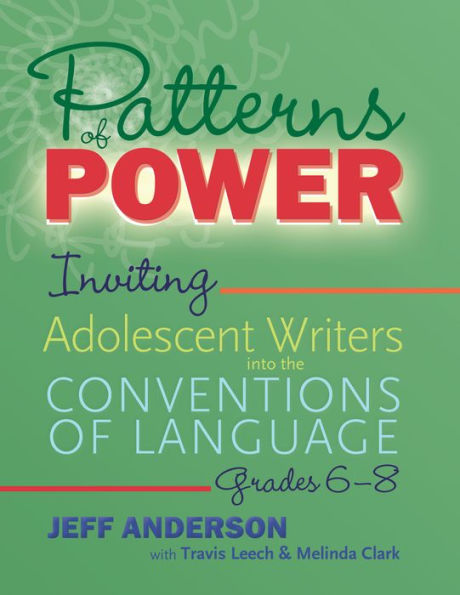Table of Contents
Acknowledgments ix
Introduction: Wired to Be Inspired 1
Part 1 Getting Started with the Patterns of Power Process 15
Chapter 1 Into Planning: What Do You Need to Do Before Teaching the Invitations? 21
Chapter 2 Into the Classroom: How Do You Teach Conventions with the Invitation Process? 35
Chapter 3 Into Application: How Do You Nudge Writers to Apply Conventions? 59
Part 2 Into the Lessons with the Patterns of Power Process 91
Chapter 4 How Do Writers and Readers Use SENTENCES? 99
4.1 What's This About? Making Sense of Subjects in Sentences and Fragments 102
4.2 Use Sentences. Mostly: Making Sense of Simple Sentences 108
4.3 If There's No Verb, Nothing Happens … or Exists: Sentences Need Verbs 113
4.4 Adjective Pileup: Coordinate Adjectives 118
4.5 The Compound Spell: Don't Allow a Noun with Two Verbs to Startle You! 123
Chapter 5 Why Do Writers and Readers Need COMPOUNF SENTENCES? 127
5.1 Compounding Interest: The Compound Sentence 130
5.2 Don't Take That Tone with Me! The Compound Sentence and And 136
5.3 Two Sentences Are Better Than One: Compound Sentences 140
5.4 But I Still Haven't Found What I'm Looking … Wait, I Did! Compound Sentence and For 144
5.5 I Will Not Be IgNORed: NOR-Version 148
Chapter 6 How Do Writers and Readers Use COMPLEX SENTENCES? 153
6.1 When Introductory Clauses … Subordinate Opener 156
6.2 To Comma, or Not to Comma: Subordinate Clause Closer 161
6.3 Comma Don't or Comma Do: AAAWWUBBIS Placement 166
6.4 Comma Which: A Relative Pronoun Clause 170
6.5 Comma Who, or No Comma Who? A Relative Pronoun Closer 175
6.6 Beyond the Breakwaters: More Than AAAWWUBBIS 181
Chapter 7 How Do Writers and Readers Use PHRASES and CLAUSES? 189
7.1 If You Continue … The Conditional Mood 193
7.2 Could You Say That Another Way? The First Interrupter Is an Appositive Experience 197
7.3 Double the Comma Fun: Interrupters 201
7.4 It Don't Mean a Thing If It Ain't Got That -Ing: Participial Phrases as Closers 205
7.5 Creating a Setting: Prepositional Phrases 209
7.6 Closing Time: Ending Sentences with the Holy Renamer 214
7.7 Thatery and Whichery: The Essential and Nonessential Clauses That Tell Which One 218
7.8 Whodunit: Who or Comma Who'? What Makes a Clause Essential or Nonessential? 223
Chapter 8 What Does the MOOD of a VERB Do for Writers and Readers? 229
8.1 Subjects Come First: The Active Voice 232
8.2 Say It Plainly and Directly: What's Indicative of the Indicative Mood? 238
8.3 Write Commanding Sentences: That's Imperative! 242
8.4 To Be or Not to Be: The Basics of Infinitives 246
8.5 Wishes and Probability: If I Were You, I'd Understand the Subjunctive 250
Chapter 9 How Do Writers and Readers Use VERBALS? 255
9.1 Shopping for Participles: The Bling of Sentences 257
9.2 Inviting Understanding: Gerunds Are Activities 261
9.3 To Infinitive and Beyond! The Definitive Infinitive 266
Chapter 10 What Does PUNCTUATION Do for Writers and Readers? 271
10.1 This, That, and the Other: Serial Commas 277
10.2 And a One, and a Two, and a Three: Colons Introduce Lists 282
10.3 He Said, She Said, They Said: Colons Introduce Quotations 288
10.4 Birds of a Feather: Semicolons 293
10.5 Don't Be Afraid; Use Semicolons! 297
10.6 Dashing Through the Sentence: Dash Interruption 301
10.7 A Little Extra: Using Parentheses 305
10.8 Where We Put Extra Goodies: (Parentheses) 309
10.9 Wait for It … Ellipsis to Indicate a Pause or Break 314
10.10 Less Is More: Ellipses to Show Omission 318
10.11 Quotation Marks Dialogue 323
10.12 That's What's Up: Apostrophes 328
Chapter 11 What Do PRONOUNS Do for Writers and Readers? 333
11.1 Who We Are: Introducing Pronouns 336
11.2 My, My, My Boogie Shoes: Possessive Pronouns 342
11.3 Respect Yourself: Reflexive Pronouns 351
11.4 Make Yourself at Home: Reflexive and Intensive Pronouns 356
Chapter 12 How Do Writers and Readers Continue Using CAPITALIZATION? 363
12.1 Capitalize Names: It's a Date with Proper Nouns 366
12.2 Capitalizing on Shortcuts: Initials, Initialisms, and Acronyms 371
Chapter 13 What Other Amazing Things Can Writers and Readers Do? 377
13.1 Sophisticated Sentence Mash-Up: Compound-Complex Sentences 381
13.2 Comma Mash-Ups Can Be Gross: Coordinate Adjectives and Commas in a Series 387
13.3 Feeling Coordinated? Importance of Order with Noncoordinate Adjectives 392
13.4 Can You CorRELATE? Correlative Conjunctions 399
13.5 Conjunctivitis Connections: Conjunctive Adverbs 404
Conclusion: Connection over Correction 411
Appendix A The Patterns of Power, Grades 6-8 Soundtrack 413
Appendix B Patterns of Power Instruction in Remote Learning Environments 417
Professional Bibliography 425
Young Adult Literature Bibliography 427
Index 431



